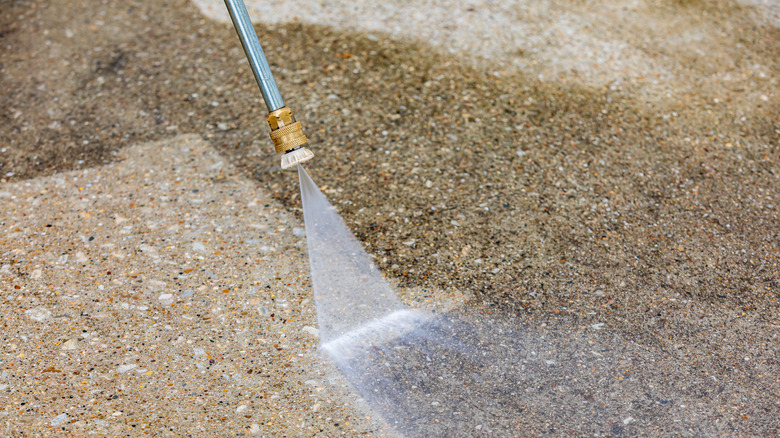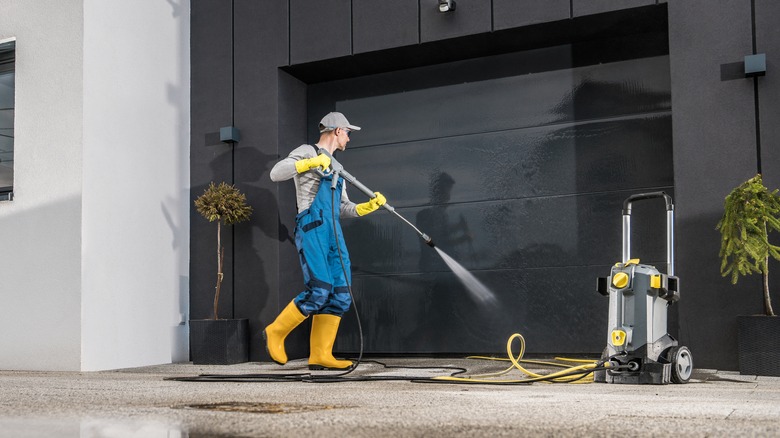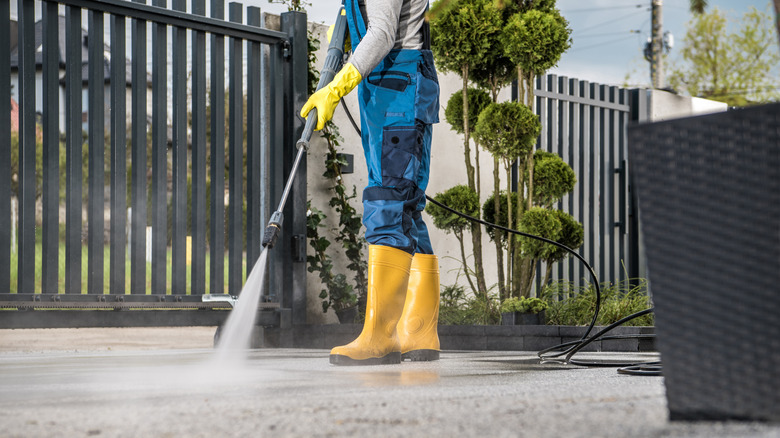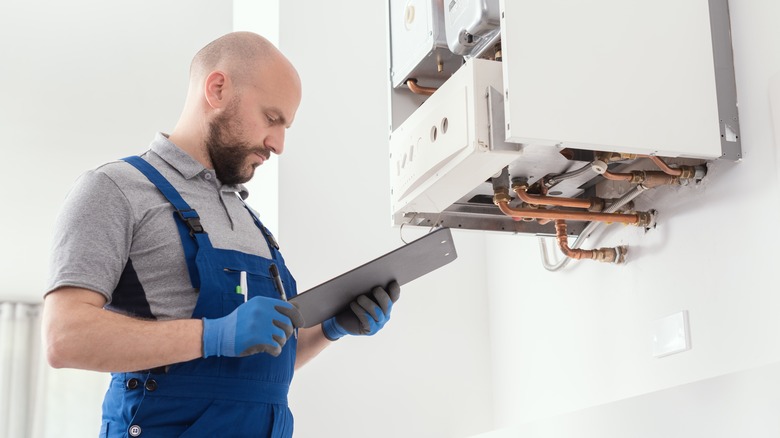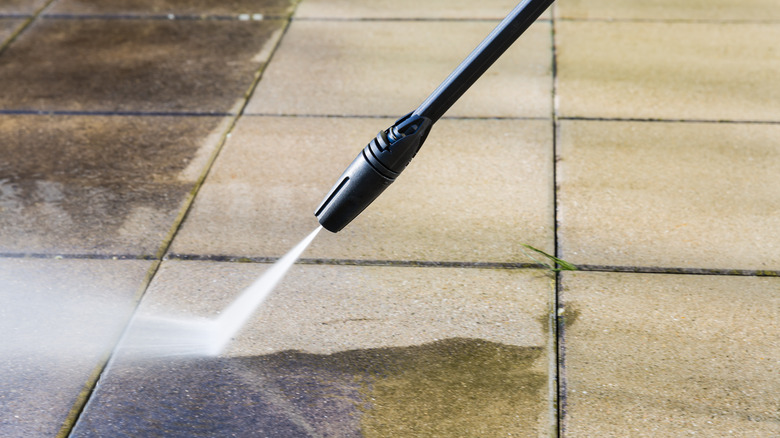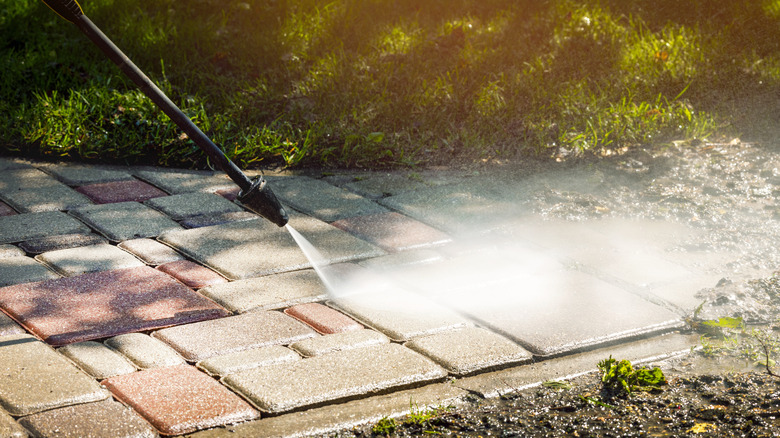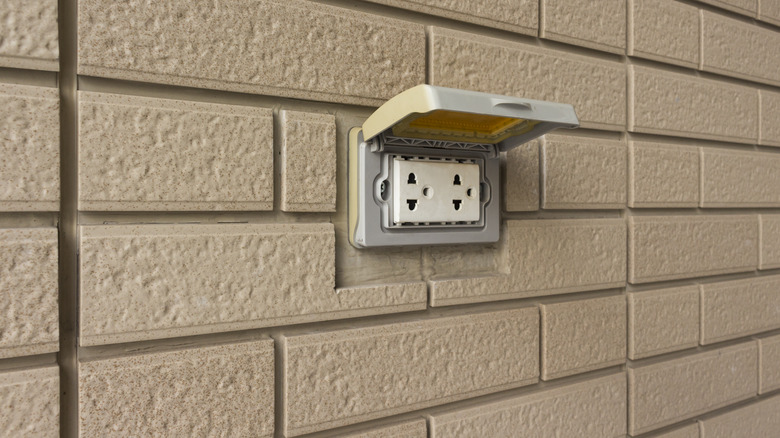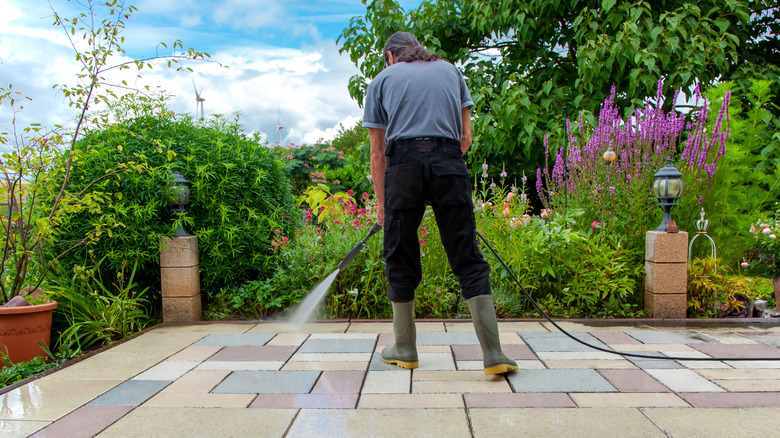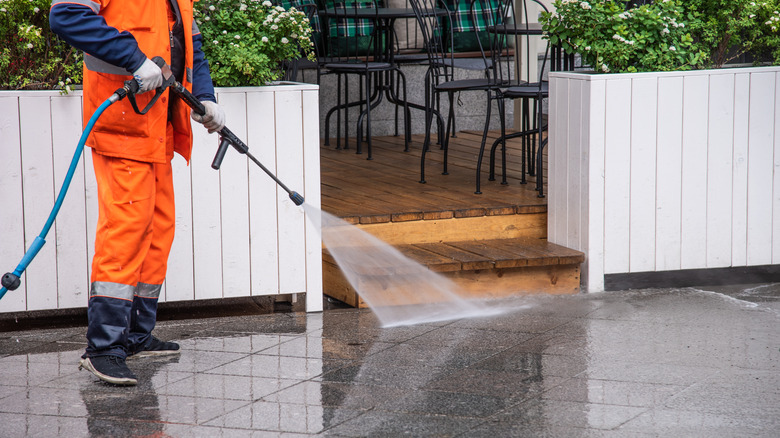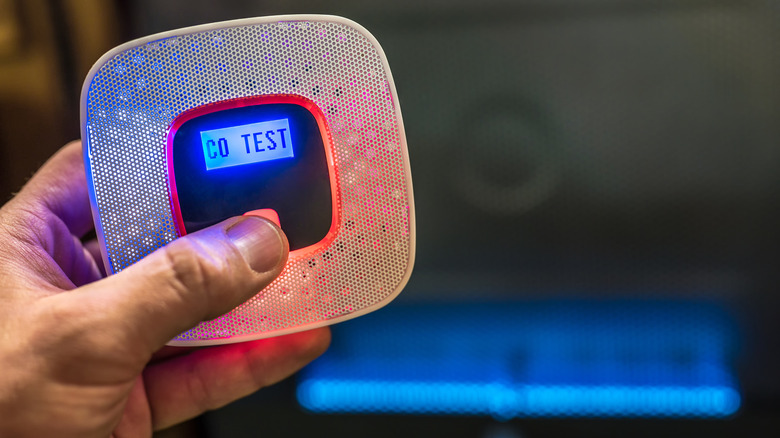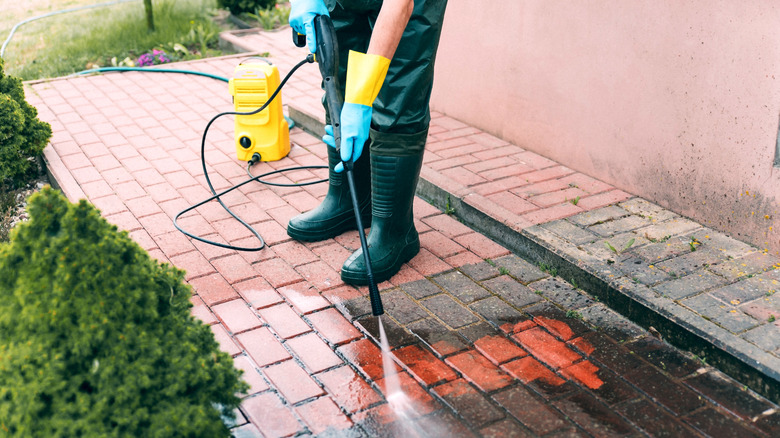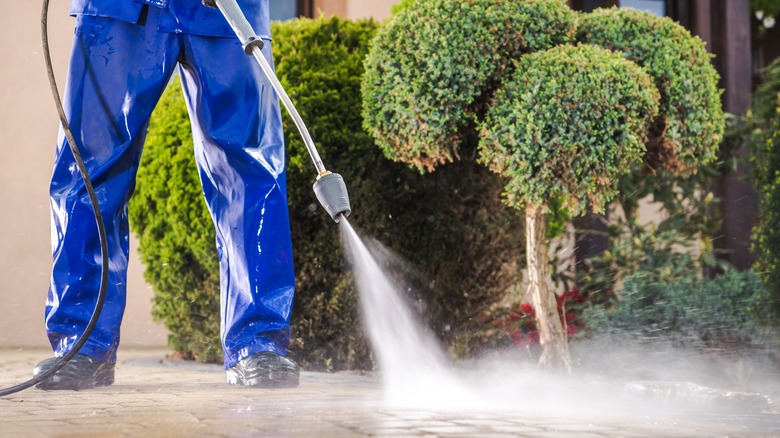12 Precautions To Take When Pressure Washing Your House This Spring
Pressure washing is a great way to refresh the exterior of your home. You can use the technique to remove dirt, grime, and debris from the siding, sidewalk, etc. However, you must take precautions to avoid damage to your home or severe injury to yourself. The pressure produced by a power washer can vary, but most residential pressure washers typically operate at pressures ranging from 1,300 PSI (pounds per square inch) to nearly 3,000 PSI.
A quick Google search of "pressure washing injuries" is enough to turn anyone's stomach. We won't make you look, but the water comes out of the hose with such force that it can cause severe mutilation to the body, including deep lacerations to the skin, loss of digits, and bone exposure. These injuries are extremely painful and often require surgery and long-term physical therapy to heal from.
While there is nothing like algae-free siding on your house or a back deck that looks new again, neither of these things is worth losing a finger. Yet each year, millions of Americans use pressure washers at home without incident. Luckily, it is not hard to avoid injury and achieve great results. These safety precautions are simple and easy to follow. Even if you've never used a pressure washer before, you'll be a pro in no time!
Clear the area you intend to wash
Ensuring the area you intend to pressure wash is empty is essential to staying safe. Before starting, take the time to remove absolutely everything. If washing the back porch, remove all outdoor furniture, plant pots, and lawn ornaments. If you are cleaning the driveway, ensure your car, trailer, boat, etc., are all parked on the street. Do a once over for children's toys, packages, and things like rocks, large sticks, etc.
The reason for this is to protect both your safety and the item's structural integrity. The powerful stream of water can bounce off certain heavier things, giving it the potential to loop back and really hurt you. In addition, the extreme water pressure can dent your vehicles, shatter your plant pots, and damage your furniture. By keeping these things out of the way, you can make sure this doesn't happen.
In addition to keeping inanimate objects away from your pressure washer, also be sure to keep other members of your household, like kids and pets, out of the way, too. Although many dog owners enjoy having Fido around while working outside, having a pet near a pressure washer is unsafe. Like so, small children should be kept inside while you are washing to avoid an accident.
Wear protective clothing
While it might seem a little over-the-top, wearing full safety gear can actually save your life. Remember that pressure washing isn't just "rinsing off the driveway." To start, you should always wear goggles or safety glasses. This keeps dust and other grit from blowing back into your eyes and causing discomfort and even cornea scratches. In some cases, larger pebbles might also fly back toward your face, causing more damage. For this reason, it is better to be safe than sorry.
To maintain balance and keep your feet safe if you lose control of the nozzle, wear non-slip, close-toed shoes. You might feel more comfortable in rubber rain boots, which will keep your feet dry. Some might even prefer wearing steel-toed boots as an added precaution. Whatever you choose, sandals like Crocs, Birkenstocks, or flip-flops are dangerous to wear when pressure washing because they leave your feet vulnerable. As you typically point the stream of water down, wearing jeans can keep your legs safer from an out-of-control spout, as the water will have more resistance before getting to your skin. For the same reason, many pressure washers also wear rubber gloves to keep a barrier between the water and their skin, just in case.
Thoroughly read the manual
No one likes to read the directions, but it's a must when using a pressure washer for the first time (or the first time in a long time!). You can't just wing it, as it's a dangerous piece of machinery. Guessing what's right can land you in the hospital. In general, knowing the dangers of the machine itself is essential before even getting into the ways the device can hurt you during use. That is, the manual will point out things like places you might pinch your fingers, crush your feet, or burn yourself.
The manual will also give you specific instructions on operating that specific machine. Even if you are a pressure washing pro, if you've always used a specific model and rented a new kind, all sorts of things can be different. The safety switch could be in another spot, the nozzle might have a spray delay, and the time you can safely run it might vary. Without taking five minutes to look through the manual to understand these important steps, you might be left stranded holding a hose with a deadly-force spray coming out of it, not knowing how to turn it back off.
Test the pressure washer and make a plan
We all know the saying, "practice makes perfect," and this is especially true when using a pressure washer. Before you start cleaning any surface, be sure to take the machine for a test run. You can do this by making a plan before you begin. Armed with the correct protective clothing and knowledge from the manual, consider cleaning a small area first. For example, you might decide to spray one panel of siding across the length of the house and then stop and assess if that's the best way going forward. It's the same idea as working your way down the driveway or across the deck.
If you just think, "OK, I'm ready to go!" and set off without a plan of attack, you might end up stuck. Always pause after your first few moments of using the machine to check that everything is functioning as it should, you feel in control, and you are getting the results you wanted. As you become more comfortable with your pressure washing skills, this step might become more of a mental check-in rather than a full test and pause sequence. But at the beginning, it is essential.
Choose the right pressure setting
Some pressure washing machines have different levels of spray. To start, always choose the lowest setting possible. You can discover how to set the stream to low by looking at the manual that comes with the machine. By selecting a gentle option at the beginning, you will be fully in control of the device before revving up the power. You don't want to knock yourself over when turning the hose on, nor have the hose push itself out of your hand. If you drop the hose while it is on, the pressure from the water can lacerate your legs. That would be no fun.
In addition to hurting yourself, using too intense pressure on the material you are cleaning can also damage the surface. For example, if you are pressure washing your deck or vinyl siding, using a high setting might splinter the wood or crack the siding. The wooden splinters cause a safety hazard if pushed up and back toward you by the stream of water. You can also hurt yourself after the fact by walking over the splintered wood or getting something caught on the cracked siding.
Watch out for electrical hazards
To avoid the danger of electrical shock or electrocution, turn off all power in the area you plan to use the pressure washer. Water is a good conductor of electricity, so it can be lethal not to plan ahead. This means unplugging appliances and shutting off the circuit breaker to the outlet or area where you'll work. As an added precaution, you should also keep the pressure washer away from electrical outlets and appliances to avoid accidentally spraying them so they are not wet when you turn them on again.
Pressure washing can create a lot of water spray and splashing, making it difficult to control where the water goes. Water can easily get into electrical outlets or nearby appliances, even if you are not intentionally spraying them. Of course, most of us would never put water in an electrical socket on purpose, but it's tough to predict where the water might end up. To be safe, while turning off or protecting the outlets, do so in a larger area than you might assume you need. If you're still unsure how to safely pressure wash around electrical outlets, talk to an electrician about turning off the outlets, or hire a professional to do the cleaning.
Never hold anything you are pressure washing
Pressure washing can be addicting. There is something so satisfying about watching the grime melt off your home's siding and front porch. When you are finished with the major cleaning, you might find yourself looking around your yard for more things to wash off. If you decide to clean smaller items, like lawn furniture, metal grates, etc., remember never to hold anything in your hand as you clean it off.
Even if the item is small, always lean it up against the side of your home (or another stable structure) before using the machine to clean it. If it's small enough that the blast of water moves it around too much, it should not be pressure washed and should be cleaned by hand. Because you need one hand free to operate the machine, holding items in the other hand creates an unstable environment. It's very possible to get off-kilter and miss-aim the stream of water. Unfortunately, since holding an item means it's a lot closer to the hose's base, the water's power is even stronger, and the injury to your hand is even more severe.
Always engage the safety latch
The pressure washer isn't just a hose, so it's serious if it gets away from you. Its safety latch is designed to prevent the trigger gun from accidentally being pulled and spraying water at high pressure, causing serious harm. The safety latch is usually located on the handle of the trigger gun and is a small lever that must be held down to use the pressure washer. However, be sure to check your machine's manual for the exact way it works before moving forward.
When you are not spraying, be sure always to engage the latch. Even if you are taking a brief pause because you feel a sneeze coming on, or someone shouted a question at you from the back porch, engage the latch. This is an important step to prevent accidents. It only takes one moment of forgetfulness or accidental carelessness before you find yourself in an ambulance on the way to the emergency room. It's not worth it to think you don't need to press the safety latch because "you'll be quick," and your mind won't wander.
Be wary of gas-powered machines inside
Rooms that are somewhat "indoors" might still need to be pressure washed, like the garage or the basement. However, when using a gas-powered pressure washer inside these spaces, even if they are only semi-enclosed, you must be extra careful about avoiding carbon monoxide (CO) poisoning. CO is a gas with no color, smell, or taste. It is highly toxic to humans and animals, so breathing it in can cause severe symptoms, sometimes even death. When inhaled, it binds to the hemoglobin in our red blood cells. These are the cells that normally carry oxygen around the body. When these cells get stuck, it reduces the amount of oxygen the body can receive.
This causes hypoxia (oxygen deprivation) in vital organs such as the brain and heart. Things start with getting a headache, feeling dizziness and weakness, then getting nauseous and confused. However, the symptoms appear so rapidly that you lose consciousness quickly. To avoid getting hurt in this way, only use a gas-powered pressure washer in the garage with the door fully open. In the basement, open all the windows and perhaps even set up a fan to bring in the fresh air. If you feel sick, immediately turn off the machine and leave the space.
Take your time when turning off the machine
You still need to keep safety on the top of your mind even when you are finished using the machine. If you don't properly shut down, you might cause injury to the next person who uses it. Because just like regular water hoses can retain water when turned off, so can pressure washers. If you don't turn off the machine the right way and drain the hose, the water pressure may continue to build up and could potentially cause the hose to burst or spray water unexpectedly, seriously hurting someone.
In addition to the risk of bodily harm, turning off the pressure washer without care can cause damage to the machine, too. The continued pressure built up inside the pump and hoses can cause a sudden pressure drop when the engine is shut down. This can damage the machine's internal mechanisms, like the seals, pistons, and valves. If you've rented the machine, this can be a costly fix as the store might hold you financially accountable to replace it. If you use a gas-powered pressure washer, shutting off the water supply without turning off the engine can cause the machine to overheat. This can lead to burns when touching the machine, even after letting it cool for a little bit. So be extra careful to turn the device off when it's not in use for longer than a few moments.
Hire a professional if necessary
Renting a pressure washer from a local hardware store like Home Depot or Lowe's is easy. You also might be able to borrow one from a friend or a colleague for an afternoon to take care of your project. However, you might get the machine home and decide it's not as easy as you thought. If you're uncomfortable or not confident with pressure washing, consider hiring a professional to complete the project instead. They have the experience and equipment necessary to do the job safely and effectively.
Most handymen or general contractors will offer pressure washing services, although there might be a minimum spend, plus a callout fee required. Some other businesses also sell pre-set packages like "driveway + sidewalk," "sidewalk + siding," "back patio," etc. As people can operate pressure washers without training, there typically isn't much insurance or licensing for businesses that offer the service. Instead, a few good reviews and photos of their previous projects should be all you need to ensure you hire the right person for a job. Sometimes, it's even possible to ask the friend who owns the pressure washer to spend the afternoon helping you out in exchange for a little cash or another gift.
